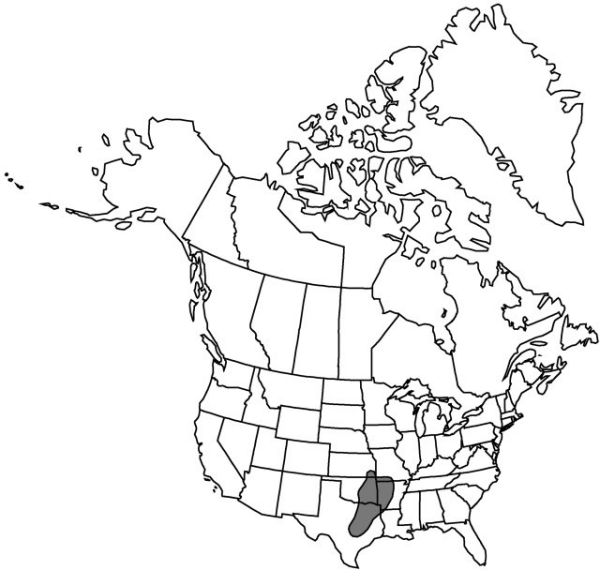Difference between revisions of "Yucca arkansana"
Rep. (Annual) Missouri Bot. Gard. 13: 63. 1902.
FNA>Volume Importer |
FNA>Volume Importer |
||
| Line 12: | Line 12: | ||
|name=Yucca angustifolia var. mollis | |name=Yucca angustifolia var. mollis | ||
|authority=Engelmann | |authority=Engelmann | ||
| + | |rank=variety | ||
}} {{Treatment/ID/Synonym | }} {{Treatment/ID/Synonym | ||
|name=Yucca arkansana var. paniculata | |name=Yucca arkansana var. paniculata | ||
|authority=McKelvey | |authority=McKelvey | ||
| + | |rank=variety | ||
}} {{Treatment/ID/Synonym | }} {{Treatment/ID/Synonym | ||
|name=Yucca glauca var. mollis | |name=Yucca glauca var. mollis | ||
|authority=Engelmann ex Branner & Coville | |authority=Engelmann ex Branner & Coville | ||
| + | |rank=variety | ||
}} | }} | ||
|hierarchy=Agavaceae;Yucca;Yucca arkansana | |hierarchy=Agavaceae;Yucca;Yucca arkansana | ||
| Line 33: | Line 36: | ||
|elevation=100–400 m | |elevation=100–400 m | ||
|distribution=Ark.;Kans.;Mo.;Okla.;Tex. | |distribution=Ark.;Kans.;Mo.;Okla.;Tex. | ||
| − | |discussion=<p><i>Yucca arkansana</i> shows considerable variation, particularly in the eastern part of its range. S. D. McKelvey (1938–1947) described < | + | |discussion=<p><i>Yucca arkansana</i> shows considerable variation, particularly in the eastern part of its range. S. D. McKelvey (1938–1947) described <i></i>var.<i> paniculata</i> and suggested that it is an eastern extension of the species with a taller, paniculate, and pubescent inflorescence. <i>Yucca arkansana</i> approaches Y. louisianensis, which we have reduced to synonymy under <i>Y. flaccida</i>. K. H. Clary’s (1997) DNA consensus tree places <i>Y. arkansana</i> and Y. louisianensis adjacent to one another.</p> |
|tables= | |tables= | ||
|references= | |references= | ||
| Line 42: | Line 45: | ||
-->{{#Taxon: | -->{{#Taxon: | ||
name=Yucca arkansana | name=Yucca arkansana | ||
| − | |||
|authority=Trelease | |authority=Trelease | ||
|rank=species | |rank=species | ||
| Line 57: | Line 59: | ||
|publication year=1902 | |publication year=1902 | ||
|special status= | |special status= | ||
| − | |source xml=https://jpend@bitbucket.org/aafc-mbb/fna-data-curation.git/src/ | + | |source xml=https://jpend@bitbucket.org/aafc-mbb/fna-data-curation.git/src/f50eec43f223ca0e34566be0b046453a0960e173/coarse_grained_fna_xml/V26/V26_902.xml |
|genus=Yucca | |genus=Yucca | ||
|species=Yucca arkansana | |species=Yucca arkansana | ||
Revision as of 20:53, 16 December 2019
Plants forming small colonies, acaulescent or caulescent; rosettes usually small. Stems decumbent, short, to 0.2 m. Leaf blade mostly yellowish green, flattened, grasslike, concavo-convex, widest near middle, 20–60(–70) × 0.7–2(–2.5) cm, flexible, margins entire, curled, filiferous, apex long, tapering to short spines 1.6–3.2 mm. Inflorescences racemose, occasionally paniculate proximally, arising within rosettes or at rosette level, 3–6(–8) dm, glabrous; bracts erect; peduncle scapelike, 0.2–0.5(–0.6) m, 0.3–0.7(–1.3) cm diam. Flowers pendent; perianth globose; tepals distinct, greenish white, elliptic to orbicular or oblong, 3.2–6.5 × 2–5 cm; filaments 1.3–2.5 cm; anthers 3.2 mm; pistil 2.5–2.8(–3.2) cm; style dark green, 7–13 mm, tumid; stigmas lobed. Fruits erect, capsular, dehiscent, oblong-cylindric to obovoid, constricted near middle, stout, 4–6.5(–7) × 2–3 cm, dehiscence septicidal. Seeds dull black, thin, ca. 1 cm diam.
Phenology: Flowering spring.
Habitat: Gravelly soil, limestone outcrops, rocky hillsides, prairies
Elevation: 100–400 m
Distribution

Ark., Kans., Mo., Okla., Tex.
Discussion
Yucca arkansana shows considerable variation, particularly in the eastern part of its range. S. D. McKelvey (1938–1947) described var. paniculata and suggested that it is an eastern extension of the species with a taller, paniculate, and pubescent inflorescence. Yucca arkansana approaches Y. louisianensis, which we have reduced to synonymy under Y. flaccida. K. H. Clary’s (1997) DNA consensus tree places Y. arkansana and Y. louisianensis adjacent to one another.
Selected References
None.